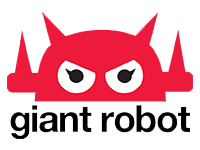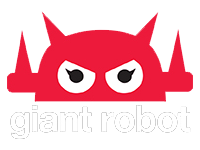Giant Robot Store and GR2 News
Greetings from Chicago
This is Tim Hugh and his dog Helga in his kitchen in Chicago. Tim has run the only Asian American Indie Film Fest (i.e. no “imports”) for 12 of the 17 years that it’s been in existence. In this picture, he’s a one man bandleader- running it solo, something I can relate to as a solo musician. I’m in town to promote my film “Daylight Savings” which premiered at SXSW this year, and will be the opening night film this year. Joining me at the screening will be Michael Aki who plays my cousin in the film. I met Mike at this very festival in 2010 when he was showing his films Sunsets that he directed with Eric Nakamura, and his Film Noir tribute “Strangers”
I asked Tim a bunch of questions:
Goh: Why is this festival important?
Tim: It’s one of the only festivals that shows only Asian American films; produced, directed and/or about the Asian American experience. In the midwest more so than the coastal states, you’re constantly asked that stupid question “Where are you from?”… so it’s important to help define what being Asian and American is.
I’m a fourth generation Chinese American. In the midwest, it’s usually under the assumption that you’re just “Asian”… and not “Asian American.” When I see Causasian people I don’t ask them “are you from Poland? are you European?” I just see them for who they are, not what they look like.
Goh: How did you get involved in the festival?
Tim: I was just a fan of the band Seam, and Sooyoung Park, Ben Kim and Billy Shin started the festival in 1995 after they released the Ear of the Dragon CD, which was the first Asian American Rock Compliation. I’d always go and watch everything I could. I’d never seen films like this before; Asian American characters that spoke like me; the actors weren’t forced to speak with a bad accent. I could relate to these images and characters that I was seeing at this festival.
I became obsessed and would watch everything I could, whether it be a feature, documentary, or shorts program. I just wanted to see as much as I could, because I knew I’d never get a chance to see these movies again. Plus, being able to meet the directors and hear them speak about their films was one of the coolest things for me. I remember hanging out with Justin Lin, back when he was just a shorts director.
They noticed me being there year after year, and began to recognize me. Eventually, they would ask me to do little things like hand out program booklets, take tickets, watch the table, and take pictures during the Q&A’s. Basically, I became a volunteer. I remember standing there back in the day giving out Giant Robot magazines!
What follows is a brief report on the most recent of my trips to the disaster-afflicted areas in Tōhoku. Refer to my GR piece about the four trips I took to the North during the first month of the disaster.
 As I reported previously, Kazu, my brother-in-law in Onagawa, and I had devised an (admittedly vague) guerilla-style plan to distribute doner kebab, pita sandwiches, and possibly ice cream to those in need. Typically, Kazu drives his truck into Sendai and sells pita sandwiches as o-bento lunch for office workers there, and he recently augmented his truck with a Dairy Queen-type ice cream maker to entice local customers. (Though Sendai is a good-sized metropolis, Onagawa is a small fishing town, and kebab considered quite exotic there.) Obviously, the Tōhoku disaster brought business to a screeching halt. With no electricity to power the refrigeration at home, and no petrol for the truck or generator, Kazu had given away all his remaining stock to survivors the first day after the quake and tsunami, and the truck had sat idle in his backyard since. So, we envisioned, I’d re-supply him with fresh ingredients (meat, veggies, pita, yogurt, and ice cream) and he’d give away hot meals to folks living in the refugee centers. Or something like that. You hear about kids in the early days of Japan’s occupation, now in their seventies, fondly recalling the taste of chocolate and bubble gum given them by GIs; perhaps a generation of kids will grow up in Tōhoku with similar memories of their first kebab.
As I reported previously, Kazu, my brother-in-law in Onagawa, and I had devised an (admittedly vague) guerilla-style plan to distribute doner kebab, pita sandwiches, and possibly ice cream to those in need. Typically, Kazu drives his truck into Sendai and sells pita sandwiches as o-bento lunch for office workers there, and he recently augmented his truck with a Dairy Queen-type ice cream maker to entice local customers. (Though Sendai is a good-sized metropolis, Onagawa is a small fishing town, and kebab considered quite exotic there.) Obviously, the Tōhoku disaster brought business to a screeching halt. With no electricity to power the refrigeration at home, and no petrol for the truck or generator, Kazu had given away all his remaining stock to survivors the first day after the quake and tsunami, and the truck had sat idle in his backyard since. So, we envisioned, I’d re-supply him with fresh ingredients (meat, veggies, pita, yogurt, and ice cream) and he’d give away hot meals to folks living in the refugee centers. Or something like that. You hear about kids in the early days of Japan’s occupation, now in their seventies, fondly recalling the taste of chocolate and bubble gum given them by GIs; perhaps a generation of kids will grow up in Tōhoku with similar memories of their first kebab.
And, after all, who doesn’t like a good ice cream cone?
 First task: acquiring 60kg of Australian topside beef in 5mm slices, and 3kg each of minced lamb and beef. Lack of power, and brownouts in some dairy-producing parts of Japan have made yogurt scarce as well (I’d recently heard about a friend’s wife outsmarting supermarket restrictions on dairy purchases by lining up in disguise). And, then, several kilos of fresh cabbage and tomatoes. Issaku, owner of my favorite Tokyo izekaya, had the meat delivered to me on ice (no point trying to cram that much into my fridge); and Mo, a brother-in-law living in Tokyo, collected requisite yogurt and vegetables. So far, so good. I also agreed to give a ride up north to Gome, a young rapper and skateboarder whose best friend was 3rd AD on my second feature, and who’d lost touch with his family in Onagawa. During the drive north Gome would keep us alert with his hip-hop demos.
First task: acquiring 60kg of Australian topside beef in 5mm slices, and 3kg each of minced lamb and beef. Lack of power, and brownouts in some dairy-producing parts of Japan have made yogurt scarce as well (I’d recently heard about a friend’s wife outsmarting supermarket restrictions on dairy purchases by lining up in disguise). And, then, several kilos of fresh cabbage and tomatoes. Issaku, owner of my favorite Tokyo izekaya, had the meat delivered to me on ice (no point trying to cram that much into my fridge); and Mo, a brother-in-law living in Tokyo, collected requisite yogurt and vegetables. So far, so good. I also agreed to give a ride up north to Gome, a young rapper and skateboarder whose best friend was 3rd AD on my second feature, and who’d lost touch with his family in Onagawa. During the drive north Gome would keep us alert with his hip-hop demos.
 I rented a 6-seater van (called, delightfully I thought, a “Bongo“) the day before setting out and rode out to Asakusa-bashi to stock up with relief supplies at Second Harvest Japan, the food bank for which I’d already made a couple relief runs to the North. Charles McJilton, director of Second Harvest, loaded me up with about 300 bananas, 40 cases of fig cookies (donated by the French), and several boxes of canned fruit, and gave me a target: a school doubling as a refugee camp in Natori City, en route to Onagawa. But Charles also warned me that a couple drivers had recently been turned away at their destinations. Multiple governmental and non-governmental organizations are now supplying the North, but unavoidable overlap and, alternately, poor coverage in the various towns and villages affected have resulted in some points oversupplied, while others still lack the basics. Meanwhile, national and local bureaucratic controls have tightened, making it difficult for many grass-roots volunteer parties to get through. So, I told Charles, I’d stop off in Natori and see if they’d take the supplies, but if not needed there, I’d continue north and locate an alternate beneficiary in Ishinomaki or Onagawa, my ultimate destinations.
I rented a 6-seater van (called, delightfully I thought, a “Bongo“) the day before setting out and rode out to Asakusa-bashi to stock up with relief supplies at Second Harvest Japan, the food bank for which I’d already made a couple relief runs to the North. Charles McJilton, director of Second Harvest, loaded me up with about 300 bananas, 40 cases of fig cookies (donated by the French), and several boxes of canned fruit, and gave me a target: a school doubling as a refugee camp in Natori City, en route to Onagawa. But Charles also warned me that a couple drivers had recently been turned away at their destinations. Multiple governmental and non-governmental organizations are now supplying the North, but unavoidable overlap and, alternately, poor coverage in the various towns and villages affected have resulted in some points oversupplied, while others still lack the basics. Meanwhile, national and local bureaucratic controls have tightened, making it difficult for many grass-roots volunteer parties to get through. So, I told Charles, I’d stop off in Natori and see if they’d take the supplies, but if not needed there, I’d continue north and locate an alternate beneficiary in Ishinomaki or Onagawa, my ultimate destinations.
We set off from my flat at 5:30 AM on April 14th and made good time getting up into Miyagi Prefecture, stopping a few times along the way to top off the Bongo’s gas tank (but, I have to admit, blasting through Fukushima Pref. without stopping). We got off the Tōhoku Expressway for our stop in Natori, but the only official we managed to meet at our target, Natori Fujigaoka Primary School, having been newly dragooned from her usual post in Kyōto, was unfamiliar with local procedures and unable to direct us towards any appropriate facilities. We’d read some recent newspaper headline about shortages in Onagawa, so we decided to continue on, lest our cargo spoil.






